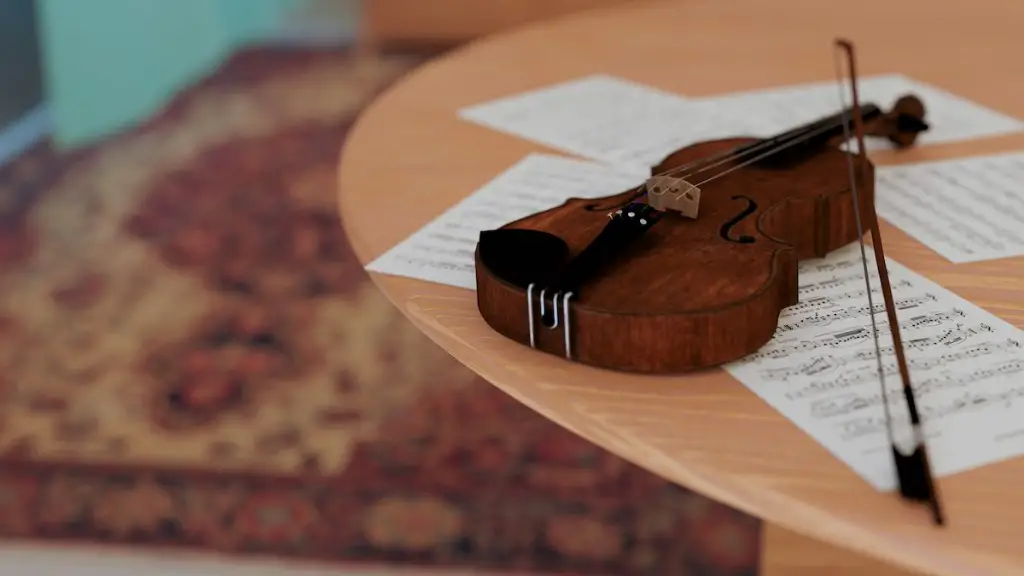Violin rosin is essential to producing a warm, resonant sound from the instrument. It is used to increase the friction between the bow hair and the strings, which produces the sound. Violin rosin is typically made from tree resin, beeswax, and sometimes other ingredients.
The process of making violin rosin involves extracting tree resin from coniferous trees and then refining it into a pale yellow or golden-colored substance. The tree resin is then mixed with beeswax in order to create a paste-like material that can easily be applied to the bow hair. The ratio of beeswax to tree resin varies depending on the desired texture and consistency of the end product. For example, some musicians prefer a softer rosin while others may want a harder one.
After mixing these two ingredients together, they are heated until they form an homogeneous mixture. This mixture is then poured into molds and left to cool until it has reached its desired shape and texture. Lastly, it is packaged and labeled so that violinists can easily identify what type of rosin they are purchasing.
Overall, making violin rosin isn’t too complicated as long as you have all of the necessary ingredients at hand. It’s also important to remember that every musician has their own preference when it comes to choosing their rosin, so finding what works best for you may require a bit of trial and error! Different Types of Rosin Available
Rosin is a sticky substance made from tree and plant resins, used by violinists and other string players. It helps create friction between the bow and strings for a better sound. There are many types of rosin available, each with its own unique properties that can affect the sound produced. Soft rosins provide more grip, while harder rosins are better for producing long-lasting tones. Rosin can also be mixed with different additives to change its color or improve its properties.
Violin rosin is made by heating tree resin until it melts and then allowing it to cool and harden again into a solid form. This process helps to purify the resin and remove any impurities or particles that could interfere with the sound produced. Different types of tree resin are often blended together to create different effects, such as providing greater grip or producing a brighter sound on the strings. The rosin may also be blended with various additives such as waxes or essential oils for smoother application.
The Ingredients Used in Making Violin Rosin
Violin rosin is a sticky, wax-like substance used to help the bow move smoothly across the strings of a violin. It is made from natural ingredients such as tree resins and beeswax, which are heated and blended together until they form a highly concentrated paste. The paste is then molded into small cakes that are ready to use on the strings of the violin. The beeswax helps give the rosin its sticky texture, and it also helps to protect the bow from wear and tear. Other ingredients such as pine resin, conifer resin, or colophony may also be added to create different types of rosin with varying levels of grip and durability.
Violin rosin can vary in color depending on what ingredients are used in its making, with lighter colors usually indicating higher quality. To ensure that your violin has good sound quality, it’s important to use high-quality rosin that is specifically designed for your instrument. Using a good quality rosin will help protect the strings from wear and give you the best possible sound quality for your violin.
Making Violin Rosin
Violin rosin is a natural resin that is used to increase friction between the bow hair and the strings of a violin, producing a better sound. It is made from pine tree resin, which has been collected and then boiled in water. The boiling process helps to remove impurities and create a higher quality product. Afterwards, the resin is filtered and then heated to form blocks of rosin. The blocks are then either cut into small pieces or ground into a powder which can be used directly on the bow hair. Additionally, the blocks can be melted down and mixed with other ingredients to create special types of rosin with unique properties. Finally, this mixture is poured into molds and allowed to cool until it hardens into usable pieces of rosin.
In summary, violin rosin is made from pine tree resin that has been boiled in water to remove impurities and create a higher quality product. The resin is then filtered, heated, cut or ground into pieces or powder, melted down with other ingredients for special types of rosin, and finally poured into molds where it cools until it hardens. This process ensures that violinists have access to high-quality rosin to use while playing their instrument.
Refining the Violin Rosin
Violin rosin is made from the resin of pines and other coniferous trees. The resin is collected from the bark and then melted in a hot water bath. It is then strained and allowed to cool, forming a solid block of rosin. The block is then cut into small pieces, which are ground into a fine powder. The powder is heated at a very high temperature until it melts, forming a liquid rosin. This liquid is filtered to remove impurities and cooled again until it forms an amber-colored paste that is ready for use on violin bows. The refining process ensures that the rosin produces the best possible sound on the violin. After the refining process, violin rosin can be sold in its original form, or combined with other materials to form different types of rosins with unique properties.
Testing the Quality of the Violin Rosin
Violin rosin is made from a combination of beeswax, tree resin and sometimes other ingredients. The beeswax and resin are heated until they melt and can be mixed together. This mixture is then poured into a mold to form the rosin cake. The cake is left to cool and harden, then it is ready to be used on a bow to provide friction between the bow hair and strings. The quality of rosin can vary greatly, so it’s important to test it before use. Some ways to test the quality of violin rosin include testing its durability, its stickiness, and its ability to produce a good sound. Durability tests can involve rubbing it against paper or cloth to see if it leaves any residue or if it becomes brittle. Stickiness tests involve pressing two pieces of paper together with some rosin in between them and seeing if they stick together. Finally, sound tests involve playing a note with rosin applied on the bow hair and listening for clarity and resonance in the note. With these tests, musicians can determine which type of violin rosin works best for them.
Storing the Violin Rosin for Future Use
Violin rosin is a sticky substance used to help create friction between the bow and strings. It is made from a combination of various resins, waxes, and oils that are melted together and cooled until hardened. It is an essential part of playing the violin, as it helps to increase sound quality and gives musicians greater control over their instrument. To ensure that violin rosin lasts for multiple playing sessions, it should be stored in an airtight container in a cool, dry place. Additionally, it should be kept away from direct sunlight or any other sources of heat that could melt or damage the rosin.
It is important to note that storing rosin in a plastic bag or any other non-airtight container can cause it to become dry and brittle over time. Furthermore, never store rosin in an area where temperatures fluctuate greatly, as this can cause condensation to form inside the container and make the rosin wet. To ensure that your violin rosin remains usable for long periods of time, you should check on it periodically and replace it if it appears dry or otherwise unusable.
The End
Rosin is an essential item for violinists as it allows their bows to grip the strings properly. It is a resin-like substance made from pine tree sap and other natural ingredients. Rosin is produced by pressing and melting the ingredients together, resulting in a product that is both sticky and smooth. To create different grades of rosin, various mixtures of ingredients are used so that players can select the type best suited for their playing style. It’s important to remember that rosin should be replaced regularly in order to maintain good sound quality.




